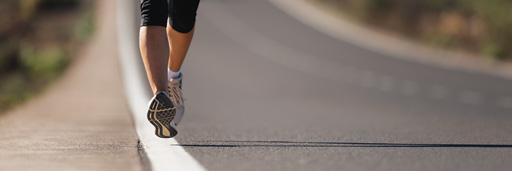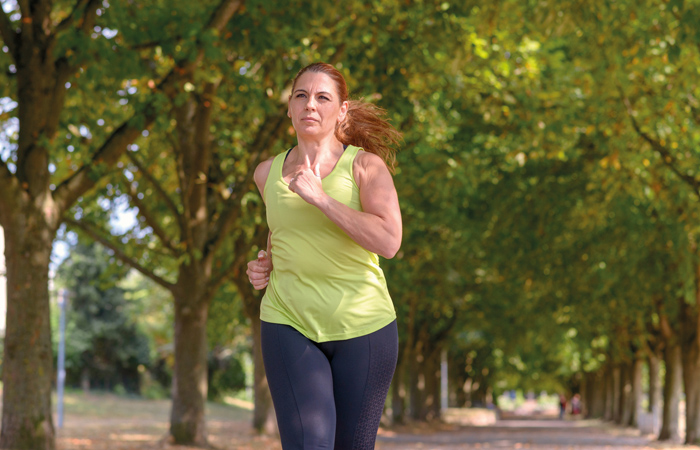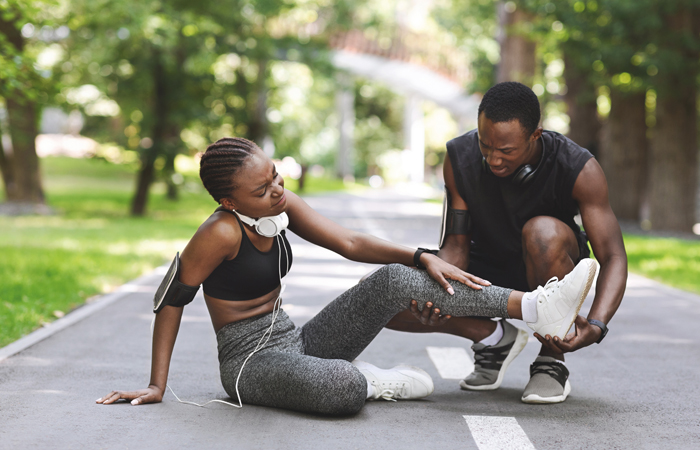Finding routes to fitness
In OTC
Follow this topic
Bookmark
Record learning outcomes
Physical activity can make a huge difference to health and wellbeing, but despite numerous public health campaigns promoting its benefits, many people remain inactive and obese

Learning objectives
After reading this feature you should be able to:
• Identify ways you can encourage people to do more physical activity
• Have a much better understanding of which sports nutrition products and supplements to stock
• Advise on treating common sports and fitness injuries
Despite living in a FitBit age, in which many people are enthusiastic about taking up a range of sports and activities, the most recent Health Survey for England reveals that 64 per cent of adults are overweight or obese, while figures from Public Health England (PHE) show the population is around 20 per cent less active than it was in 1961. In some communities only one in 10 adults are active enough to stay healthy. If current trends continue, the nation will be 35 per cent less active by 2030.
This inability to get moving is having dire health consequences. According to PHE, physical inactivity directly contributes to one in six deaths in the UK, the same number as smoking. So why is the country falling so short? It seems there are several social, cultural and economic reasons. Technology has taken over in the home and at work, so fewer people have physical jobs. Long periods spent in front of a computer or television and people’s reliance on cars and other motorised transport rather than walking or cycling also take their toll.
As a result, almost 20 per cent of adults aged 25-34 years are classified as inactive (meaning they take part in fewer than 30 minutes of physical activity per week). And this figure gets worse with age – over 50 per cent of those over 75 years are inactive.
Although these figures make it look as if it is mainly older people who are most in need of physical activity, Tim Andrews of DW Fitness First, the UK’s second largest gym operator, says every age group is guilty of not being as active as they should. “The current Government guidelines for physical activity recommend that we perform at least 150 minutes of moderate aerobic activity per week, including two days of strength training. However, statistics provided by UK Active reveal that only 34 per cent of men and 24 per cent of women aged 19-65 years currently meet these guidelines.”
PHE also points out that those who are regularly engaging with healthcare professionals (which equates to those with or at risk of developing health conditions) are far more likely to be inactive.
Physical inactivity directly contributes to one in six deaths in the UK
Benefits of moving
Fortunately, there is plenty of data pharmacists can share with customers about the benefits physical activity can have on both physical and mental wellbeing.
Although weight loss is the result that most people relate to when taking up a more active lifestyle, Tim Andrews says there are “endless benefits, both physical and mental, to keeping on top of your fitness”.
PHE stresses that people who have a physically active lifestyle have a 20-35 per cent lower risk of cardiovascular disease, coronary heart disease and stroke compared to those who have a sedentary lifestyle. Regular physical activity is also associated with a reduced risk of diabetes, osteoporosis and colon/breast cancer, and improved mental health. In older adults, physical activity is linked to increased functional capacities.
Physical activity also releases endorphins that relieve stress and fight depression. “Regular fitness routines are a fantastic way to build confidence, as a person can see exactly what they are capable of and how far they have progressed,” says Andrews.
Being active also plays a key role in brain development in early childhood and is also good for longer-term educational attainment. Increased energy levels boost workplace productivity and reduce sickness absence, says PHE, which claims that an active population can even reduce levels of crime and antisocial behaviour.
Pivotal role for pharmacy in joint pain
Musculoskeletal experts and patient organisations are warning that the burden of joint health problems is set to place an unprecedented strain on society and an already overstretched NHS. Experts predict that 7 million more people in the UK will suffer from arthritis by 2030, taking the total number of arthritis suffers to 17 million.
A new Joint Health of the Nation Report produced by Lanes Health (manufacturer of GOPO) and leading arthritis organisations calls for five steps to be implemented:
• Self-management
• Tailored prevention programmes
• Earlier intervention
• Psychological support
• Speed up referrals and access to treatment.
“Pharmacists can play a pivotal role in steering people with joint pain towards a prevention programme, promoting lifestyle and diet changes, including recommending clinically proven joint-specific supplements, such as the galactolipid GOPO,” says consultant rheumatologist Dr Rod Hughes. “GOPO has been shown to help protect and repair joints, and should certainly be considered for patients at the early onset of even mild joint pain.”

Pharmacy on board?
All this data isn’t new – so if we know this, why isn’t everyone exercising? A common reason is not knowing where to start or finding a programme that is easy to stick to, all of which gives pharmacy teams plenty of opportunity to step in with advice and encouragement.
“Community pharmacy, with its open front door, is a great location for supporting people by promoting the benefits of exercise,” says sports scientist Paul Moloney. “As a location that is frequented by members of the public with co-morbidities and disease states that would benefit most from an increase in exercise, the two are very much interlinked.”
“A community pharmacy negates the need for an appointment and can target the demographic that possibly can’t afford a personal trainer or gym membership. The pharmacy may also have an existing relationship with patients, so the advice would be a logical add-on to its other services.”
For example, staff can suggest customers incorporate small, regular changes like walking and cycling into their lifestyle, instead of seeing exercise as something they have to go to a gym for. They are more likely to sustain these small changes and over the long-term the health benefits will pay off.
Pharmacy teams can also help customers increase their physical activity levels via the ‘Five A’s’ system, which is sometimes used in smoking cessation but can be adapted for physical activity:
• Ask about the person’s current levels of physical activity
• Assess their fitness and capabilities
• Advise about appropriate exercise and the risks involved
• Assist in helping them find places to get involved
• Arrange any necessary referrals.
Fitness trackers and other health apps can be useful tools for tech-savvy customers. According to a survey of 1,076 adults carried out by LaptopsDirect.co.uk, more than one in three (37 per cent) of those who have challenged themselves to get fitter during 2019 believe their choice of tech products is helping them to reach their goals.
Wearable fitness trackers (34 per cent) and smart watches (26 per cent) were cited as the most helpful technology, according to those surveyed, with meal planning smartphone apps (19 per cent), followed by heart rate monitors (12 per cent) and calorie counting smartphone apps (9 per cent) ranked as the next most useful pieces of tech to help with fitness goals.
To help pharmacists add to their own knowledge, PHE has developed a national Moving Healthcare Professionals programme with Sport England to support healthcare professionals develop the knowledge, skills and confidence to embed physical activity within clinical care. This programme includes the PHE Physical Activity Clinical Champions programme, which has a national network of more than 40 healthcare professionals who have already delivered free peer-to-peer training on physical activity and how to incorporate this advice in practice to over 22,000 practising healthcare professionals. To find out more or to book a session, contact physicalactivity@phe.gov.uk.
A community pharmacy can target the demographic that possibly can’t afford a personal trainer or gym membership
Key facts
• In some communities it is estimated that only one in 10 adults are active enough to stay healthy
• Losing about a pound of weight delivers almost a four-pound reduction in knee joint load for each step
• Fitness trackers and other health apps can be useful tools for tech-savvy customers
Sports nutrition
While it is important to follow a varied and balanced diet and healthy lifestyle, some people believe that sports nutrition products and supplements have a role to play in boosting performance and recovery, as well as helping to avoid injury.
Once a market mainly targeted at professional athletes, Dr Emma Derbyshire, public health nutritionist and adviser to the Health Food Supplements Information Service (hsis.org) says this has changed.
“Sports nutrition emerged in the United States in the 1940s as a niche interest of bodybuilders looking to obtain optimal nutrition in a convenient format, but things began to change with the growing awareness of the role that exercise can play in supporting a healthy lifestyle.
“As more and more people started going to the gym or for a morning run, demand for nutritional products that could help them run further, lift more, swim better or recover faster began to grow. Sports nutrition is no longer confined to simply serving body builders and is now used to allow all active people to consume the nutrition they need at the right time in the most convenient format, in conjunction with a nutritious diet.”
If this sounds like it reflects part of a pharmacy owner’s customer base, then it could be worth stocking a few key products, particularly as the sports nutrition market is growing, says Emma Derbyshire. Products include vitamins and minerals, protein powders and protein bars, branched chain amino acids, creatine supplements, fats such as omega-3s, conjugated linoleic acid (CLA) and medium chain triglycerides (MCTs), and sports drinks. The UK sports nutrition market reached £799m in 2017 – up 13 per cent on 2016 and more than double the £350m recorded in 2012, she says.
“More than 10 million people in the UK belong to a gym and events such as triathlons with running, cycling and swimming are increasing in popularity, [so] many active individuals may wish to seek advice on healthy eating, nutrition and supplements to help them excel in their regular activity or sport. Pharmacies could become a key resource, both stocking and providing information on these types of products.”
Common sports injuries
Once pharmacy teams have encouraged their customers to get moving, this opens up further scope to advise them on avoiding and managing common sports injuries at home with OTC medicines and devices.
Sprains and strains
Most sprains and strains can usually be treated with selfcare, such as the PRICE technique of protection, rest, ice, compression and elevation, and should improve within six to eight weeks, although severe muscle strains may take longer.
Topical NSAID products which offer an anti-inflammatory action together with pain relief are another option to help with muscle and joint aches and pains arising from sports injuries.
While painkillers can be used to help ease any discomfort, advise customers to see their GP if they are in severe pain or if their injury is not improving or getting worse.

Joints
Joint injuries can occur when a joint is taken outside its comfortable range of motion, so stronger stabiliser muscles and increased flexibility lessen the likelihood or severity of an injury. Maintaining a healthy weight can also be beneficial for joints. One study claimed that losing about a pound of weight delivers almost a four-pound reduction in knee joint load for each step.
Blisters
Blisters can be easily prevented by covering tender spots with a friction-resistant dressing or plaster. If blisters do occur, then specialist blister plasters are available that are said to aid rapid healing by absorbing the fluid, protecting the skin from bacteria and helping relieve the pain of friction and pressure.
It is worth reminding customers who have diabetes to be particularly vigilant when checking for blisters, as their foot injuries will take longer to heal due to poorer blood circulation.
What to stock
• Vitamins and minerals: Active physical exercise is linked with nutritional deficiencies such as vitamins A and C, iron, zinc and calcium, particularly in young athletes whose nutritional needs are increased because of growth. Prolonged bouts of heavy exercise are associated with lowered immune function. Adequate intakes of iron and zinc and vitamins A, D, E, B6 and B12 are important to maintain a healthy immune function.
• Trace minerals: Athletes tend to have lower serum zinc concentrations, suggesting their zinc requirements are higher. Serum selenium concentrations may also be lower in athletes. Iron levels may be low, especially in women of reproductive age. Requirements for specific nutrients can vary by type of sport. For example, zinc and copper requirements may be higher when the activity has a big impact on muscle mass.
• Vitamin C may aid recovery in athletes by mopping up free radicals and increasing collagen synthesis. Doses should not exceed 200mg daily. One study in 20 athletes found vitamin C supplementation could increase exercise performance in those with low levels of vitamin C. Vitamin C has also been found to be effective at preventing colds when consumed regularly by athletes training in subarctic conditions.
• Glucosamine may protect the joints in athletes. Research shows a protective effect of glucosamine on joints in football players and bicycle racers through improved cartilage metabolism
• Omega-3 fatty acids: DHA and EPA have an anti-inflammatory action. Adequate amounts of these compounds in the body tissues may facilitate healing after sports injury. Oily fish (the main dietary source of DHA and EPA) intake is lower than recommended, suggesting the need to consider a supplement.
• Protein supplements: These are frequently consumed by athletes and active adults to achieve greater gains in muscle mass and strength, and to improve physical performance. Some evidence shows that protein supplementation does increase muscle mass and endurance, but has little impact on muscle damage and recovery. The focus should be on obtaining protein from the diet.
John Bell joins forces with Bodydoctor
John Bell & Croyden has launched InResidence Fitness in partnership with the private training studios, Bodydoctor. The famous London pharmacy is now offering its customers an in-house consultation, priority booking at the Belgravia training studios and nutritional advice for training, as well as exclusive special offers, and will be collaborating with the Bodydoctor team to launch a range of ‘Bodydoctor approved’ fitness and rehabilitation products within the pharmacy.
“We are continuously editing our offer and pushing the boundaries on what services a pharmacy can provide,” says Alexander Johnston, general manager at John Bell & Croyden, “and are thrilled to collaborate with a like-minded company such as Bodydoctor Health & Fitness, who share this same approach towards holistic services in health and wellbeing.” An introductory offer costs £240.
Appropriate advice
When it comes to sports nutrition products and supplements, the range needs to be carefully selected as there are a lot of products available, says Paul Moloney. He suggests only reputable brands are stocked. “If you are advising elite athletes, you also need to be aware of the UK’s anti-doping policies and advice on supplement use.”
Elite athletes aren’t the only group who need specific advice. “A vegan diet in particular creates challenges for planning a nutritious diet for an athlete or active person,” says Emma Derbyshire. Vegans who are exercising need to make sure they are consuming enough energy (calories) and protein, as well as vitamin B12, iron, zinc, calcium, iodine and vitamin D, she says, and there is a lack of long chain omega-3 fatty acids (EPA and DHA) in most plant-based foods.
“Community pharmacists, with their knowledge of nutrition and supplements, should be the ‘go to’ professionals for sports nutrition advice as it naturally complements their skill set and expertise,” says Paul Moloney. “Consumers benefit from the advice they receive from a pharmacist as opposed to when purchasing online or from ‘pop up’, unregulated nutrition shops.”
With around 1.2 million health-related visits to a community pharmacy every day, the messages given to customers about their physical activity and how to raise it could have a big impact on their health. People are living longer than ever before, so early intervention is needed to make sure physical activity is as accessible – and its benefits and importance as well understood as possible – because it is one of the simplest and best ways of preventing ill health.
More information
• For more information about recommended weekly amounts of activity, go to: nhs.uk/Livewell/fitness/Pages/Activelifestyle.aspx
• Moving Healthcare Professionals programme
• UK Anti-Doping
